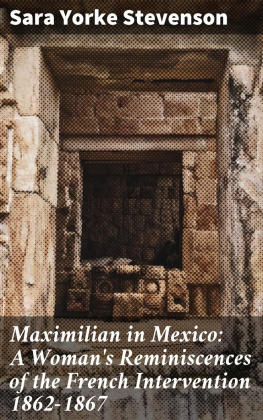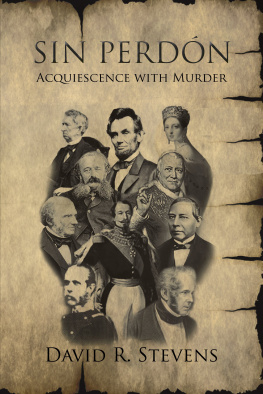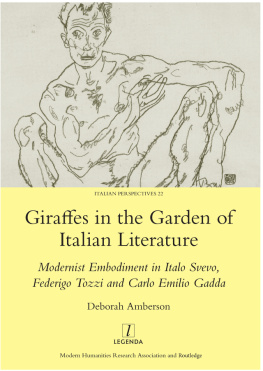Amberson - Maximilian and Carlota: Europes last empire in Mexico
Here you can read online Amberson - Maximilian and Carlota: Europes last empire in Mexico full text of the book (entire story) in english for free. Download pdf and epub, get meaning, cover and reviews about this ebook. City: San Antonio, year: 2015, publisher: Trinity University Press, genre: Home and family. Description of the work, (preface) as well as reviews are available. Best literature library LitArk.com created for fans of good reading and offers a wide selection of genres:
Romance novel
Science fiction
Adventure
Detective
Science
History
Home and family
Prose
Art
Politics
Computer
Non-fiction
Religion
Business
Children
Humor
Choose a favorite category and find really read worthwhile books. Enjoy immersion in the world of imagination, feel the emotions of the characters or learn something new for yourself, make an fascinating discovery.

- Book:Maximilian and Carlota: Europes last empire in Mexico
- Author:
- Publisher:Trinity University Press
- Genre:
- Year:2015
- City:San Antonio
- Rating:3 / 5
- Favourites:Add to favourites
- Your mark:
- 60
- 1
- 2
- 3
- 4
- 5
Maximilian and Carlota: Europes last empire in Mexico: summary, description and annotation
We offer to read an annotation, description, summary or preface (depends on what the author of the book "Maximilian and Carlota: Europes last empire in Mexico" wrote himself). If you haven't found the necessary information about the book — write in the comments, we will try to find it.
Amberson: author's other books
Who wrote Maximilian and Carlota: Europes last empire in Mexico? Find out the surname, the name of the author of the book and a list of all author's works by series.
Maximilian and Carlota: Europes last empire in Mexico — read online for free the complete book (whole text) full work
Below is the text of the book, divided by pages. System saving the place of the last page read, allows you to conveniently read the book "Maximilian and Carlota: Europes last empire in Mexico" online for free, without having to search again every time where you left off. Put a bookmark, and you can go to the page where you finished reading at any time.
Font size:
Interval:
Bookmark:



THE PUBLISHER GRATEFULLY ACKNOWLEDGES THE GENEROUS SUPPORT OF GLORIA GALT, TED AND SHARON LUSHER, AND THE SUMMERLEE FOUNDATION TOWARD THE PUBLICATION OF THIS BOOK.
Published by Trinity University Press
San Antonio, Texas 78212
Copyright 2014 by M. M. McAllen
All rights reserved. No part of this book may be reproduced in any form or by any electronic or mechanical means, including information storage and retrieval systems, without permission in writing from the publisher.
Jacket design by Rebecca Lown
Book design by BookMatters, Berkeley
Jacket illustrations:
Santiago Rebull, Maximilian von Habsburg, Emperor of Mexico, 1865. Courtesy Castello di Miramare, Trieste, Italy.
Albert Graefle, Carlota Amalia de Saxe Coburg, 1865. Courtesy Museo Nacional de Historia, INAH, Chapultepec, Mexico City, DF.
Coat of Arms of the Second Mexican Empire. Courtesy Museo Nacional de Historia, INAH, Chapultepec, Mexico City, DF.
Frontispiece: Emperor Maximilian and Empress Carlota enter Puebla, 1864
Trinity University Press strives to produce its books using methods and materials in an environmentally sensitive manner. We favor working with manufacturers that practice sustainable management of all natural resources, produce paper using recycled stock, and manage forests with the best possible practices for people, biodiversity, and sustainability. The press is a member of the Green Press Initiative, a nonprofit program dedicated to supporting publishers in their efforts to reduce their impacts on endangered forests, climate change, and forest-dependent communities.
The paper used in this publication meets the minimum requirements of the American National Standard for Information SciencesPermanence of Paper for Printed Library Materials, ANSI 39.481992.
CIP data on file with Library of Congress.
ISBN 978-1-59534-185-3 ebook
18 17 16 15 14 | 5 4 3 2 1
To my wonderful family
and friends who remind me that
none of us lives in isolation and that
we must bloom where we are planted.
Contents
The Empire is the only way to save Mexico. When one takes charge of the destiny of a nation, it is done at ones own risk, and one never has the right to abandon it.
Carlota, Princess of Belgium, Empress of Mexico, ca. June 1866
The violent collapse of the Second Empire of Mexico in 1867 was one of the most spectacular personal tragedies and political failures of the nineteenth century. At the time and over the next one hundred years, the story remained a sensation in Europe and the Americas, though often hidden against the backdrop of the American Civil War. The rise of Mexicos Second Empire succeeded in part because, in the early 1860s, the Civil War so debilitated the United States that it left Mexico, recently emerged from its own War of the Reform under the leadership of new president Benito Jurez, seemingly defenseless. A number of European countries, especially France, continued to stalk territory in the Western Hemisphere, and with the United States otherwise distracted by its own struggle between the North and South, the French recognized an opportunity to prey on Mexico, perceived by them to be feckless but strategic. Europeans believed that it was only a matter of time before the United States annexed additional lands from its southern neighbor, as they had in 1848 and 1853, so they saw a race to grab territory. The path to establishing the Second Empire of Mexico began with an 1861 invasion by the French army under Emperor Napolon III (Louis Napolon Bonaparte) using the pretext of reclaiming unpaid bond debt. With a deep-seated desire to defeat U.S. influence in Latin America and to enrich France in the process, Napolons experienced and impressive armies were determined to win against a sturdy resistance by Mexicos Republican armies. The French prevailed in pushing President Benito Jurez out of the capital and to the far desert expanses of
This curious story highlights the incongruities that occur when people of numerous cultures, in this case not only from Mexico and Europe but also Asia and Africa, come together under tense circumstances. The liminal qualities of this storyso many foreigners in a foreign landmake for a fascinating glimpse into the nineteenth century, the philosophies of European heads of state, a newly emerging Mexico, and the shake-up of the United States. Maximilians attempts to anchor an empire in this convulsive climate proved to be a test of Old World methods against a new paradigm in America. During this turbulent time, occupied by armies, officers, and diplomats from abroad, Mexico became a microcosm of erupting European geopolitics, especially in view of Prussias intent to wage war against Austria and France.
In this book, readers should note that adherents to the Mexican empire are also referred to as Imperialistas and Monarchists. Conservatives and Clerical party members who wanted to maintain a strong central Catholic Church at times encouraged a monarchy or denounced it, depending on Maximilians actions. Supporters of Jurez are also termed Liberals or Republicans, just as they were in their day. The princess Charlotte was known in Mexico and elsewhere as Carlotaso the history begins and ends with this spelling.
Over the years, the story of the reign of Maximilian and Carlota has been told in myriad ways. Authors have written of this strange and complicated saga as history, but a good many others, inspired by the raw emotion of the epic, fictionalized the story further. A number of plays and songs were written about the Second Empire, as well as a 1939 Warner Brothers motion picture simply entitled Jurez (screenplay by John Huston, with Bette Davis, Paul Muni, Brian Aherne, and Claude Rains). Clearly, however, the absurd, complicated, and tragic tale of an Austrian archduke and a Belgian princess on the throne of Mexico produced enough innate drama to stand on its own, without further fictionalization.

Authors note: In 1865, 1 Peso = 1 U.S. Dollar. 1 U.S. Dollar in 1865 = $16.25 in 2010.
Bouchout Castle, Meise, Belgium, 1900
Inspired by the spring breezes and emergent blossoms signaling the time for adventure, Carlota, a beautiful, waiflike woman, nearly sixty, princess of Belgium, and, for a brief time, the empress of Mexico, walked gently down the pier on the lake at Bouchout. Wearing a shawl, her cropped gray hair tucked into a chignon and crowned by a straw hat woven with ribbon, her chambermaid steadied her. Carlota placed her slipper on the gunwale of the small wooden rowboat, rocking it in the water. Today we leave for Mexico, she said, before stepping into the boat for a brief excursion. Rowed about by her attendants, she saw herself gliding over Lake Texcoco escorted by French military officers.


May 28, 1864, two oclock in the afternoon, Port of Veracruz, Mexico
The captain of the frigate Novara advised Maximilian and Carlota to make ready for port at the sultry bay of Veracruz on the Gulf of Mexico. The two emerged from their suites into the swirling, smoky air of the steamships quarterdeck and strained to see the peak of Mount Orizaba, the highest mountain in Mexico, which stood shrouded in a snowy fog, nearly ninety miles west. The sight of the bastion San Juan de Ula, where battalion commanders fired cannon salutes to the sovereigns, encouraged them that their arrival in the new empire of Mexico had been acknowledged. The thirty-one-year-old emperor, Austrias Ferdinand Maximilian von Habsburg, perfectly at home on the
Next pageFont size:
Interval:
Bookmark:
Similar books «Maximilian and Carlota: Europes last empire in Mexico»
Look at similar books to Maximilian and Carlota: Europes last empire in Mexico. We have selected literature similar in name and meaning in the hope of providing readers with more options to find new, interesting, not yet read works.
Discussion, reviews of the book Maximilian and Carlota: Europes last empire in Mexico and just readers' own opinions. Leave your comments, write what you think about the work, its meaning or the main characters. Specify what exactly you liked and what you didn't like, and why you think so.






